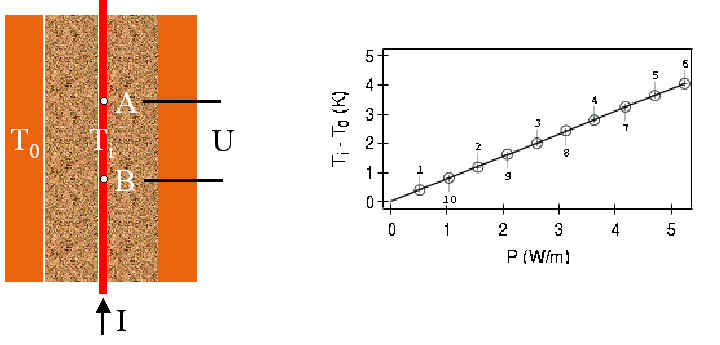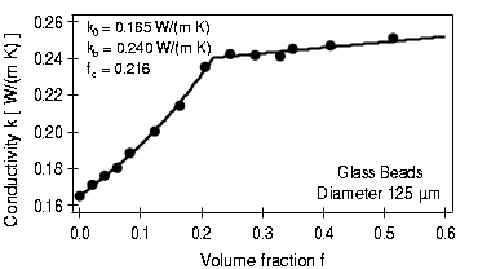
Thermal conductivity of granular materials
Collaboration with
Hervé
Gayvallet
Introduction
Granular materials are used as insulators because of their rigidity and small thermal conductivity. In a dense packing of grains, the thermal conductivity is mainly limited by the heat transfer at the contact points between the solid particles. It is difficult to determine theoretically the thermal conductivity of the granular material from the properties of the grains as neither the contacts network nor the geometry of each contact are generally known.
First experiment
We determined experimentally how addition of a small amount of water in a dry granular system changes its thermal conductivity. The principle of the measurements is as follows: the granular material is placed in a cylindrical container maintained at constant temperature T0, and is heated along the axis with the help of a simple conductive wire (heating power P, steady temperature Ti). The temperature difference (Ti-T0) depends linearly of the heating power P (Fig.1). The thermal conductivity k is deduced from the slope, which is proportional to 1/k.
Starting from dry systems, we added water and measured the variations of k. We repeated the experiment for different sizes and shape of grains as well as for different wetting conditions.

Fig.1: Principle of the measurement (left), and typical result of an experimental run (right).
We observed two regimes (FIG.2): as long as the water content does not exceed about 20% of the void space between the grains, the thermal conductivity k increases significantly due to the formation of liquid bridges at the contact points between the grains. For larger water content, the excess of water flows to the bottom of the container, and the system is no more homogeneous. The transition between the two regimes occurs when each of the contact points is surrounded by a liquid bridge. We found, for random close packings of grains, that the number of contacts per grains is about 6.5, in good agreement with the theory. The experiments are long and difficult, but they make possible to count the number of contacts per grain.

Fig.2: Conductivity k as a function of the volume fraction of water
Second experiment
We studied the heat transport along a chain of macroscopic beads: at one end, one bead is periodically heated and we record the resulting temperature variations of another bead as a function of position and time. The experimental results show that the chain behaves like a high-order low-pass filter. The measurement of the associated cut-off frequency makes it possible to determine accurately the resistance of the bead-bead contact: we make use of the experimental setup for studying the effects of liquid bridges decorating the bead-bead contacts, which provided important clues for understanding the thermal properties of wet granular matter.
Related publications
Thermal
conductivity of a partially wet granular material,
J.-C. Géminard, and H. Gayvallet,
Phys. Rev. E
64 (2001) 041301.
Thermal conductivity associated with a
bead-bead contact decorated by a liquid bridge :
An experimental study based on the response of a chain subjected to thermal
cycles,
Géminard J.-C., Bouraya D. and Gayvallet H., Eur. Phys. J. B, 48 (2005)
509-517.